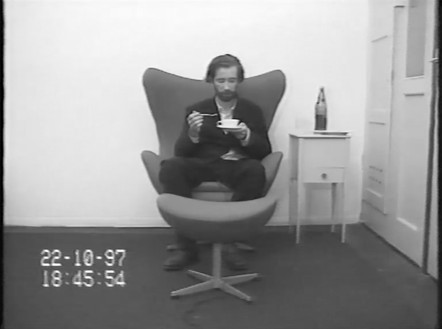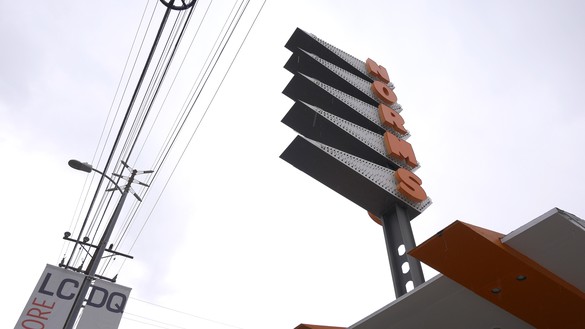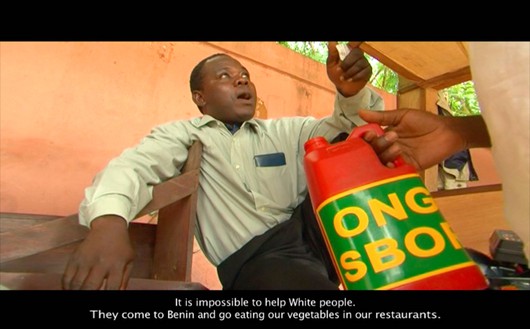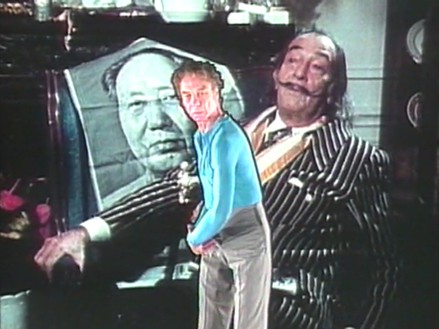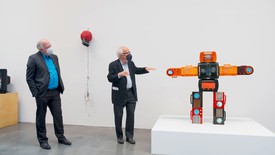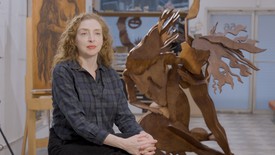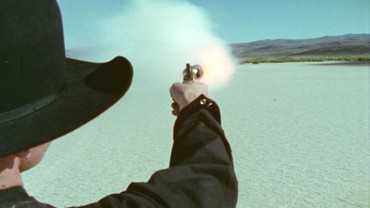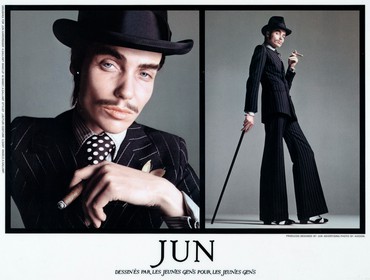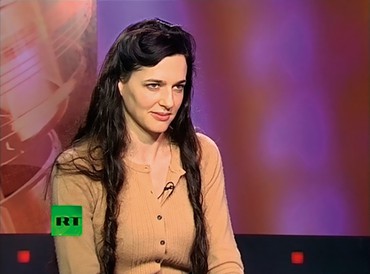About
You’re only as young as the last time you changed your mind.
—Timothy Leary
Broadcast: Alternate Meanings in Film and Video employs the innate immediacy of time-based art to spark reflection on the here and now. Looking to the late 1960s—a historical moment marked by deep uncertainty, social unrest, and radical transformation—the online exhibition loosely adopts famed psychologist and countercultural icon Timothy Leary’s mantra “turn on, tune in, drop out” as a guide for negotiating our present moment.
The second chapter presents six films and videos by artists who elaborate on themes of social topography and myth, at times intertwining the two. Ed Ruscha’s L.A. Restaurants (2019)—which will premiere in Broadcast—uses the moving image to “tune in” to the outside world, capturing the vast history embedded in Los Angeles’s distinctive vernacular restaurant architecture from Hollywood’s “golden years.” Meanwhile, in Twelve Years Over Hollywood (2008–20), Piero Golia offers a highly personal perspective on the Los Angeles milieu by “turning on” to his immediate environment through a compilation of still photographs taken from his own balcony. In NGO (Beninese Solidarity with Endangered Westerners) (2011), Romuald Hazoumè counters with a cutting reversal of the concepts of wealth and financial aid between the global North and South that reveals the impoverishment of strictly monetary valuation in determining prosperity.
Other artists in chapter two present works that focus on legend, allegory, and social commentary while still operating within the three curatorial categories. Carsten Höller consumes psychedelic substances on camera to introspectively explore childhood memories and alternate realities in Muscimol 3. Versuch (1997), while Rachel Feinstein considers gendered conventions of femininity using the framework of a children’s fairy tale in Spring and Winter (1994–96). Nam June Paik’s Good Morning Mr. Orwell (1984), in contrast, responds to a global landscape by staging a celebratory, avant-garde transatlantic broadcast that “drops out” of the conventions and norms of commercial television.
Each chapter of Broadcast will introduce a new set of films and videos on Tuesdays. The next chapter will debut on June 30.
“Turn On”
Carsten Höller
Muscimol 3. Versuch, 1997
The subject of his own experiment, Höller consumes fly agaric mushrooms and is ostensibly affected. He describes his experience before he starts to sing a German Christmas carol for children, “Ihr Kinderlein Kommet” (O, Come, Little Children) more or less comprehensibly in overtones.
Piero Golia
A Decade of Wondering above Hollywood, 2009–19
A Decade of Wondering above Hollywood comprises thousands of still photographs of the Hollywood sign taken from Golia’s Los Angeles balcony over a twelve-year period. The resulting 35mm film captures the artist’s personal documentation of his surroundings, condensing a vast temporal duration into a fleeting clip that serves as a metaphorical shorthand for broader experiences at the core of all art making.
“Tune In”
Ed Ruscha
L.A. Restaurants, 2019
L.A. Restaurants opens with a panned shot recorded while driving past Cole’s P.E. Buffet in downtown Los Angeles, which was founded in 1908 and claims to be the oldest restaurant and bar in the city. In a manner reminiscent of the typological catalogues of gas stations and buildings on the Sunset Strip first explored in his seminal artist’s books of the 1960s, Ruscha documents sixty-four restaurants emblematic of “Old Hollywood” across the LA region. This visual perambulation moves in a spiral formation, from the outer limits of the San Fernando Valley along Ventura Boulevard to the centrally located restaurants near Culver City.
Rachel Feinstein
Spring and Winter, 1994–96
Feinstein’s Spring and Winter explores themes present throughout her oeuvre. The narrative is derived from Giambattista Basile’s “Sun, Moon, and Talia” (1634), which is considered the original version of the “Sleeping Beauty” story. Fairy tales, kitsch, and the intricacies of femininity commingle as Feinstein performs as a paper doll, maiden, and crone. The spaces between the dichotomies of fiction and reality, young and old, sexual and pure are disclosed within the scope of feminine identity within this film.
“Drop Out”
Romuald Hazoumè
NGO (Beninese Solidarity with Endangered Westerners), 2011
Hazoumè’s NGO (Beninese Solidarity with Endangered Westerners) reflects on issues of immigration, economic disparity, and perceptions of wealth. Taking a critical eye toward the vast numbers of local and international nongovernmental organizations (NGOs) operating in his country of Benin, the artist created his own NGO to aid poor Westerners, thereby reversing conventional assumptions concerning poverty and the distribution of capital from so-called developed nations. In an attempt to expose the often hidden realities of the income inequality that exists in global Northern countries, he asked Beninese celebrities to solicit donations from Africans, who commonly associate Westerners with affluence. For Hazoumè, the driving concept of the project is to uncover such illusions: “To all appearances, it’s a matter of reversing the help, from south to north. But in reality—it is about making the Africans cogitate differently.”
Nam June Paik
Good Morning Mr. Orwell, 1984
On New Year’s Day in 1984, Paik premiered Good Morning Mr. Orwell, his first worldwide satellite “installation.” Featuring short prerecorded and live video performances by Laurie Anderson, Merce Cunningham, Peter Gabriel, and Allen Ginsberg, among many others, this international broadcast linked viewers across cultural and physical boundaries within the shared space of television. Paik oversaw the event and produced original graphics for the interludes between segments. Exploiting the vast potential of broadcast television when wrested from commercial enterprises, Good Morning Mr. Orwell offers a joyous yet freewheeling refutation of the concepts of mass surveillance, pervasive repression, and propaganda imagined in George Orwell’s dystopian novel 1984.
#GagosianBroadcast
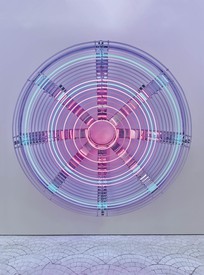
Around and Around and Around: Federico Campagna and Carsten Höller
Philosopher Federico Campagna and artist Carsten Höller came together, on the heels of Höller’s exhibition Clocks in Paris, to consider the measurement of time, the problem with fun, and the fine line between mysticism and nihilism.
Nam June Paik: Art in Process: Part One
On the occasion of Nam June Paik: Art in Process: Part One, curator John G. Hanhardt and Nam June Paik Estate curator Jon Huffman discuss the survey of works spanning the artist’s career.
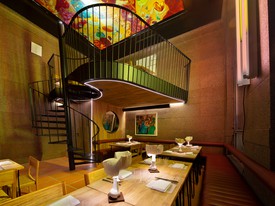
Brutalisten: An Interview with Carsten Höller
This spring, Carsten Höller launched Brutalisten, a new restaurant concept in Stockholm and the latest embodiment of his long-term culinary and artistic project called the Brutalist Kitchen. The twenty-eight-seat restaurant features a menu overseen by chef Stefan Eriksson that adheres to three classifications: “semi-brutalist” dishes (using oil or minimal ingredients), “brutalist” dishes (using salt and water), and “orthodox-brutalist” dishes (no additional ingredients). For the Quarterly, Höller speaks with Gagosian directors Serena Cattaneo Adorno and Mark Francis about this terminology, the importance of experimentation, and the fortuitous side effects of brutalist cuisine.
Rachel Feinstein: Mirror
Join Rachel Feinstein in her New York studio as she addresses the genesis of her exhibition Mirror in London and the enduring power of religious iconography.

Jean Pigozzi: An interview with Rachel Feinstein
Famed photographer of the famous, Jean Pigozzi speaks with artist Rachel Feinstein about the publication of his new book, The 213 Most Important Men in My Life, and provides a sneak peek at what’s coming up next.
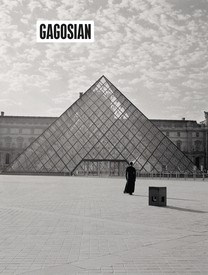
Now available
Gagosian Quarterly Summer 2021
The Summer 2021 issue of Gagosian Quarterly is now available, featuring Carrie Mae Weems’s The Louvre (2006) on its cover.
